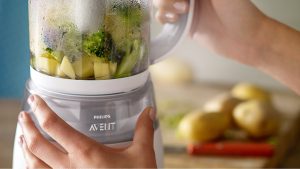
Ensuring that your baby receives the best nutrition is a top priority as a parent. While store-bought baby food may seem convenient, making homemade baby food gives you full control over the ingredients, flavors, and textures that your little one consumes. In this comprehensive guide, we will explore the benefits of homemade baby food and provide you with ten quick and healthy recipes to try at home.
Why Homemade Baby Food?
There are several compelling reasons why making homemade baby food is a great choice for busy parents. Here are a few key benefits:
- Nutritional Value: Preparing baby food at home allows you to use fresh and wholesome ingredients. You can ensure that your baby’s meals are free from preservatives, additives, and excess salt or sugar.
- Cost-Effective: Making your own baby food can be more budget-friendly compared to purchasing pre-packaged options. You can buy ingredients in bulk and prepare them in larger quantities, saving both money and time.
- Variety and Flavor: Homemade baby food enables you to introduce a wide range of flavors to your little one. You can experiment with different fruits, vegetables, and grains, promoting healthy eating habits from an early age.
- Control over Allergens: If your baby has any allergies or sensitivities, making homemade baby food allows you to carefully select ingredients and monitor their diet.
- Sustainability: By making homemade baby food, you can reduce waste by using reusable containers instead of disposable packaging.
10 Quick and Healthy Recipes for Homemade Baby Food
Here are ten tasty recipes perfect for preparing at home for your baby. Keep in mind, the importance of ensuring these recipes suit your baby’s dietary needs and any potential allergies they may have.
#1: Carrot and Sweet Potato Mash
- Ingredients:
- 1 medium carrot, peeled and chopped
- 1 small sweet potato, peeled and chopped
- Water or breast milk (as needed for consistency)
- Instructions:
- Pump breast milk and store a sufficient amount of it.
- Steam the carrot and sweet potato until tender.
- Mash or puree the steamed vegetables until smooth and the desired consistency is reached. Add breast milk or water to achieve the desired texture.
#2: Apple and Blueberry Puree
- Ingredients:
- 1 apple, peeled, cored, and chopped
- ½ cup blueberries
- Water or breast milk (as needed for consistency)
- Instructions:
- Pump breast milk and store a sufficient amount of it.
- Steam or boil the apple and blueberries until soft.
- Puree the steamed or boiled fruits until smooth. Add water or breast milk to adjust the consistency.
#3: Avocado and Banana Mash
- Ingredients:
- 1 ripe avocado
- 1 ripe banana
- Breast milk
- Instructions:
- Peel and pit the avocado. Mash it with a fork until smooth.
- Mash the banana separately. Mix the mashed avocado and banana together until well combined. Mix well with breast milk to achieve a creamy delicious texture.
#4: Spinach and Pear Puree
- Ingredients:
- 1 cup baby spinach leaves
- 1 ripe pear, peeled, cored, and chopped
- Water (room temperature)
- Instructions:
- Steam or boil the spinach and pear until tender.
- Puree the steamed or boiled spinach and pear until smooth. Add a bit of water to make it less ticker.
#5: Butternut Squash and Apple Mash
- Ingredients:
- 1 cup butternut squash, peeled, seeded, and chopped
- 1 apple, peeled, cored, and chopped
- Water or breast milk (as needed for consistency)
- Instructions:
- Steam or roast the butternut squash and apple until soft.
- Mash or puree the cooked squash and apple until smooth. Add water or breast milk to achieve the desired texture.
#6: Pea and Cauliflower Puree
- Ingredients:
- 1 cup peas, fresh or frozen
- 1 cup cauliflower florets
- Water or breast milk (as needed for consistency)
- Instructions:
- Steam or boil the peas and cauliflower until tender.
- Puree the steamed or boiled peas and cauliflower until smooth. Add water or breast milk to adjust the consistency.
#7: Pumpkin and Quinoa Mash
- Ingredients:
- 1 cup pumpkin, peeled, seeded, and chopped
- 2 tbsp quinoa, rinsed
- Vegetable broth
- Instructions:
- Steam or roast the pumpkin until soft.
- Cook quinoa according to package instructions.
- Mash or puree the cooked pumpkin and quinoa until smooth. Add vegetable broth to achieve the desired texture.
#8: Broccoli and Potato Puree
- Ingredients:
- 1 cup broccoli florets
- 1 small potato, peeled and chopped
- Water or vegetable broth (as needed for consistency)
- Instructions:
- Steam or boil the broccoli and potato until tender.
- Puree the steamed or boiled vegetables until smooth. Add water or vegetable broth to adjust the consistency.
#9: Mango and Yogurt Smoothie
- Ingredients:
- 1 ripe mango, peeled and pitted
- ½ cup plain Greek yogurt
- Breast milk
- Instructions:
- Pump a sufficient amount of breast milk.
- Chop the mango into small pieces.
- In a blender, combine the chopped mango, Greek yogurt, and breast milk.
- Blend until smooth, adding reast milk as needed to get the right texture and consistency.
#10: Sweet Potato and Lentil Soup
- Ingredients:
- 1 small sweet potato, peeled and chopped
- ¼ cup red lentils, rinsed
- Vegetable broth
- Instructions:
- Steam or roast the sweet potato until soft.
- In a separate pot, cook the red lentils according to package instructions.
- Combine the cooked sweet potato and lentils in a blender or food processor. Add vegetable broth as needed and blend until smooth.
Feeding Your Baby
Babies eat differently as they grow, and it’s important to adjust their feeding accordingly. These products offer options for various stages, from introducing solids to adapting to changing needs.
- 3 Stage Dipping Spoons:
These spoons are designed in three stages to suit different feeding needs as your baby grows. In the initial stage, when your baby is just starting to eat solids, the shallow spoon helps with small amounts. As your baby grows, you can progress to the deeper spoon for larger bites. The soft material is gentle on your baby’s gums, making it a comfortable option for the transition to solid foods. - Food Masher:
This feeding set includes a special bowl, a spoon, and a food masher. The bowl is designed for mashing and mixing baby food, making it convenient for preparing homemade purees. The accompanying spoon is suitable for feeding, and the lid helps store any leftover food. The food masher allows you to create a variety of textures, catering to your baby’s evolving taste and texture preferences. - Squeeze Feeder:
A handy tool for introducing semi-liquid or pureed foods. It comes with two spoons of different flow rates (slow and fast), providing flexibility as your baby learns to eat different consistencies. The squeezable design allows for controlled feeding, and the accompanying spoons with covers make it convenient for on-the-go feeding and storage.
Essential Tips for Making Homemade Baby Food
Preparing homemade baby food doesn’t have to be overwhelming. With the right ingredients, techniques, and storage methods, you can create nutritious meals for your baby in no time. Follow these essential tips to ensure success:
Selecting the Right Ingredients
When choosing ingredients for your homemade baby food, always go for fresh, organic options whenever possible. Here are some recommended choices:
- Fruits: Select ripe and soft fruits like kiwi, pears, bananas, mangos, dragon fruit and blueberries. These can be steamed or mashed to a smooth consistency.
- Vegetables: Choose nutrient-rich vegetables such as carrots, sweet potatoes, broccoli, peas, spinach, and cauliflower. These can be steamed, boiled, or roasted before pureeing.
- Grains: Introduce grains like quinoa and lentils to provide essential carbohydrates and protein. These can be cooked until tender and mashed or blended.
- Protein: As your baby grows, incorporate protein-rich foods like chicken, turkey, and tofu. Ensure that these are cooked thoroughly and pureed to an appropriate consistency.
Preparing the Ingredients
Proper preparation of ingredients is crucial to ensure your baby’s safety and enjoyment. Follow these steps:
- Wash and peel: Rinse fruits and vegetables thoroughly, removing any dirt or debris. Peel the skin off as needed.
- Remove seeds and pits: Remove any seeds or pits from fruits before using them in your recipes.
- Cut into small pieces: For easy cooking and pureeing, cut fruits and vegetables into small, uniform pieces.
- Steam, boil, or roast: Depending on the recipe, you can steam, boil, or roast the ingredients until they are soft and tender.
- Mash or puree: Use a blender, food processor, or immersion blender to achieve the desired consistency. Add water or breast milk to thin out the puree if needed.
Cooking Techniques
Different cooking techniques can add variety and depth to your homemade baby food. Here are a few options to try:
- Steaming: Steaming helps retain the nutrients and natural flavors of the ingredients. This method is particularly effective for fruits and vegetables.
- Boiling: Boiling is an efficient way to cook grains, such as quinoa and lentils. It ensures they become soft and easily digestible.
- Roasting: Roasting vegetables like sweet potatoes and butternut squash brings out their natural sweetness and enhances the flavor of baby food.
- Mashing: Mashing can be done with a fork or potato masher to create soft and chunky textures. This technique is ideal for introducing more texture as your baby progresses to thicker foods.
- Pureeing: Pureeing creates a smooth and silky texture, perfect for young babies who are new to solids. It can be achieved using a blender or food processor.
Storing Homemade Baby Food
Proper storage is essential to maintain the freshness and safety of homemade baby food. Follow these guidelines:
- Refrigeration: Store freshly prepared baby food in airtight containers. Refrigerate for up to three days to ensure its quality and safety.
- Freezing: If you wish to prepare larger batches in advance, freezing is a convenient option. Use ice cube trays or silicone baby food storage containers to freeze individual portions. Once frozen, transfer the cubes into labeled freezer bags or containers. Frozen baby food can be stored for up to three months.
- Thawing and Reheating: Thaw frozen baby food by transferring it to the refrigerator overnight or heating it using the defrost function on your microwave. When reheating, make sure to mix well and check the temperature before serving.
Conclusion
Homemade baby food offers numerous advantages for busy parents who want to provide their little ones with wholesome and nutritious meals. By following the essential tips provided in this guide, you can confidently prepare homemade baby food. Additionally, the ten quick and healthy recipes mentioned here will give you a head start in creating delicious meals that your baby will love. Enjoy this exciting journey of introducing your little one to the joys of homemade baby food!



